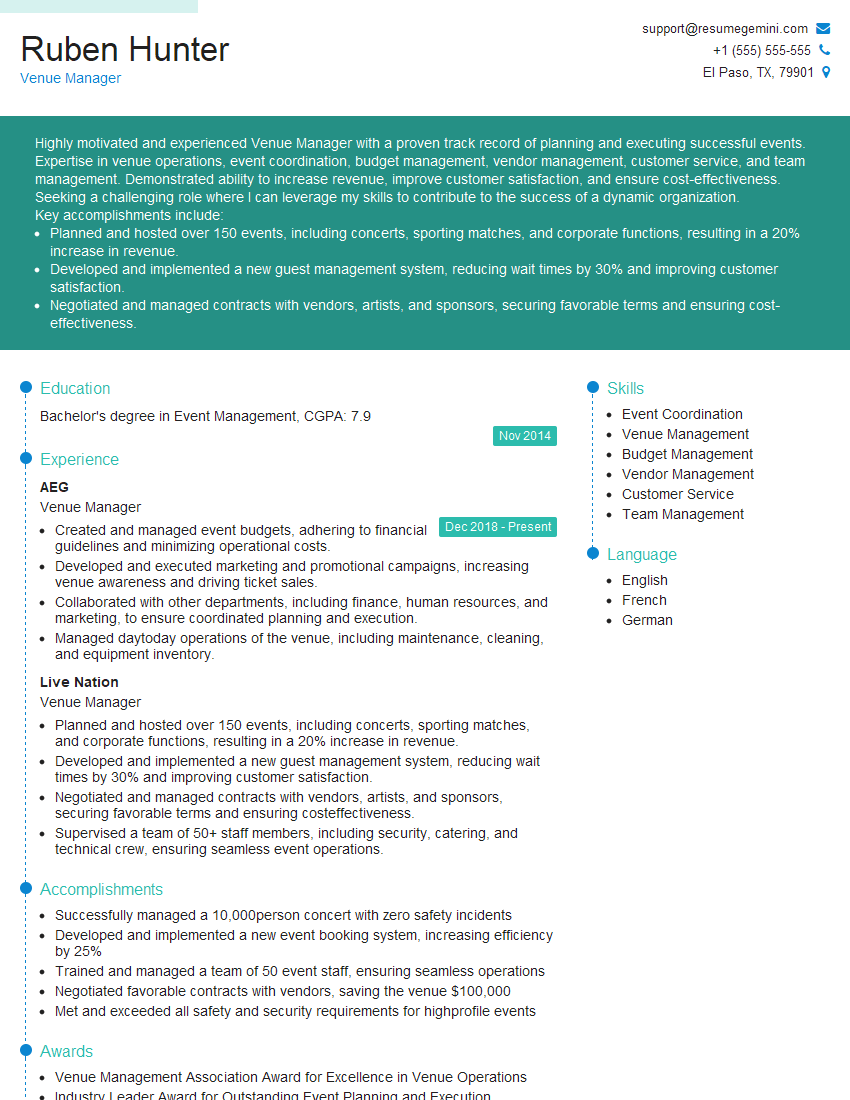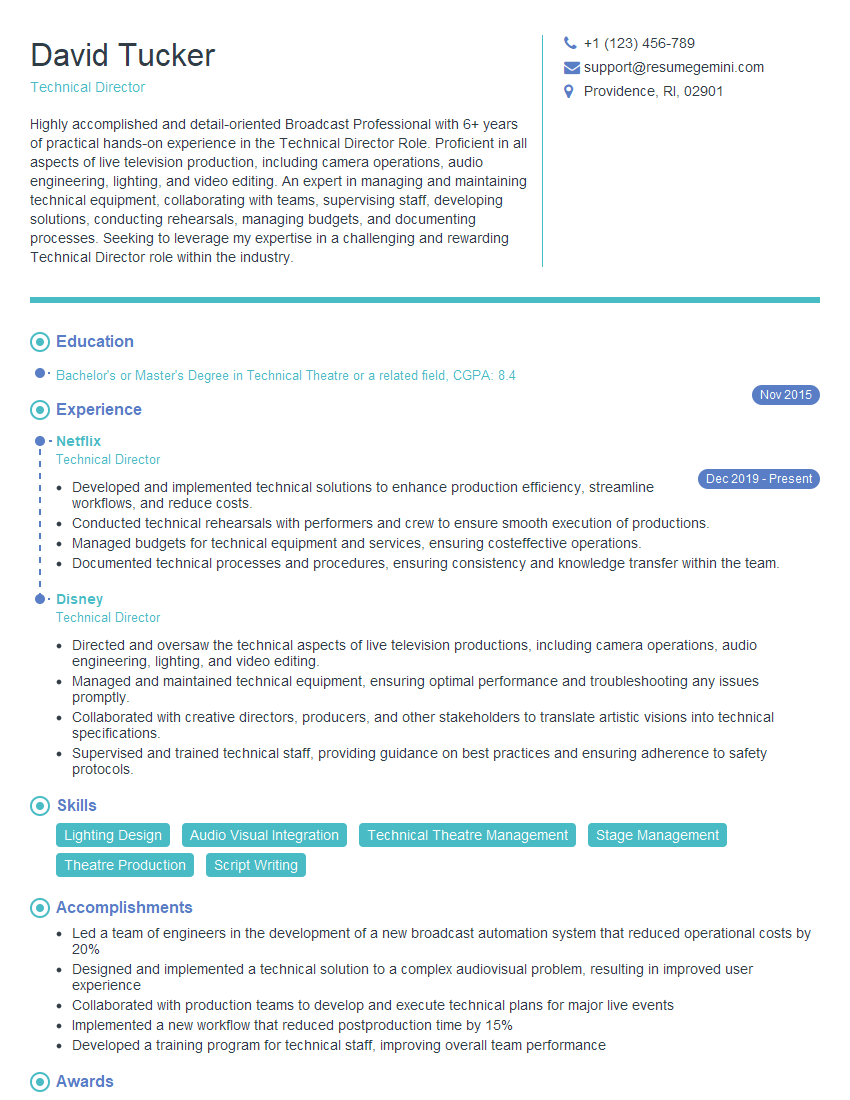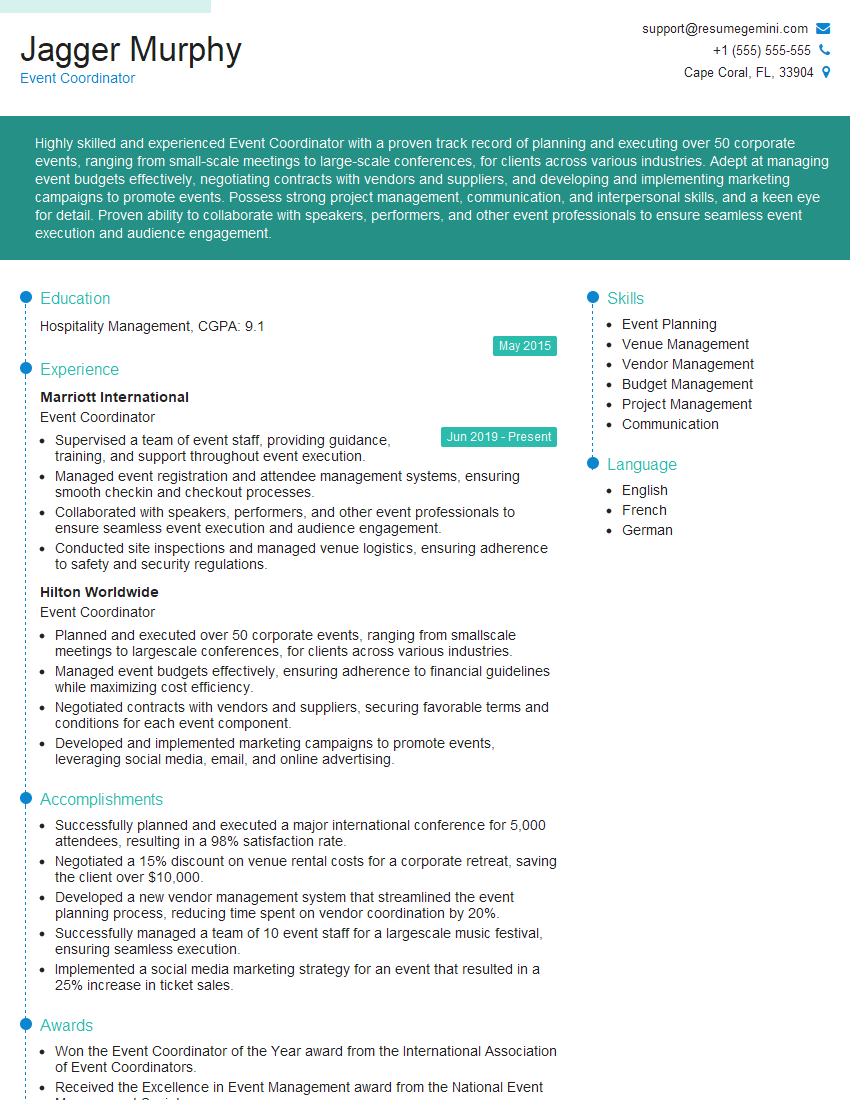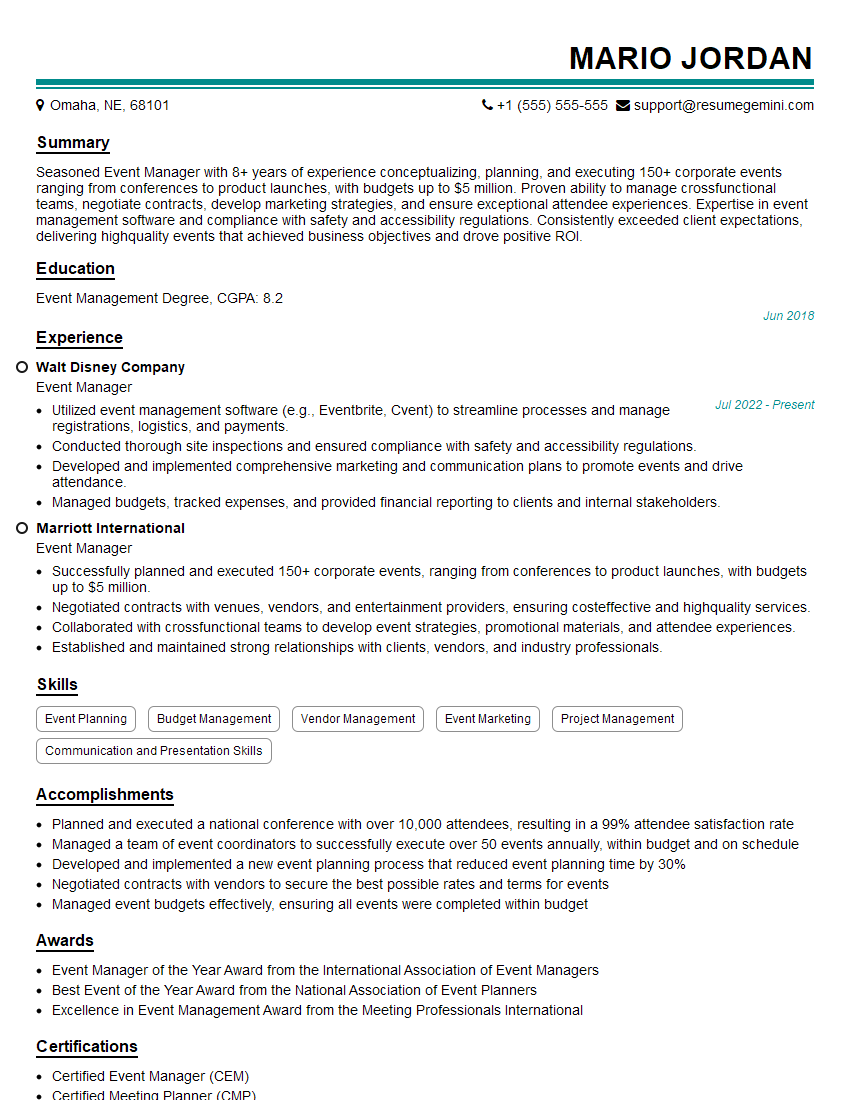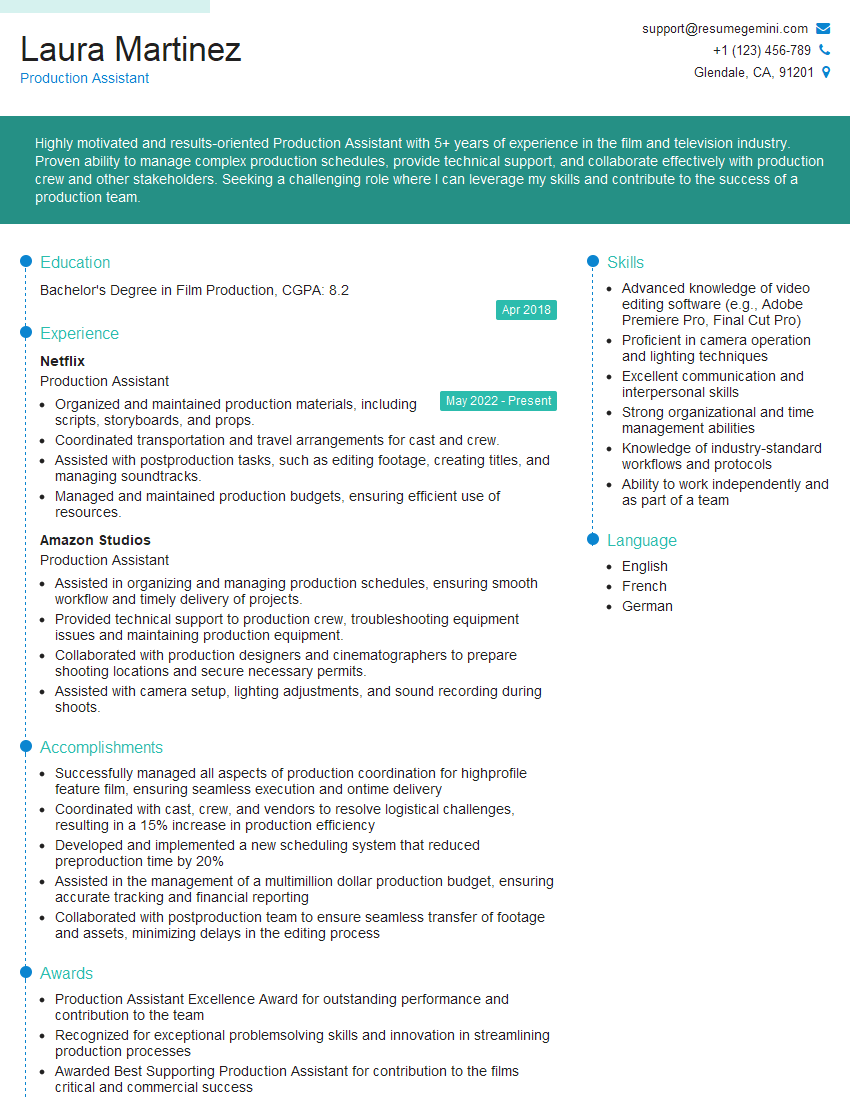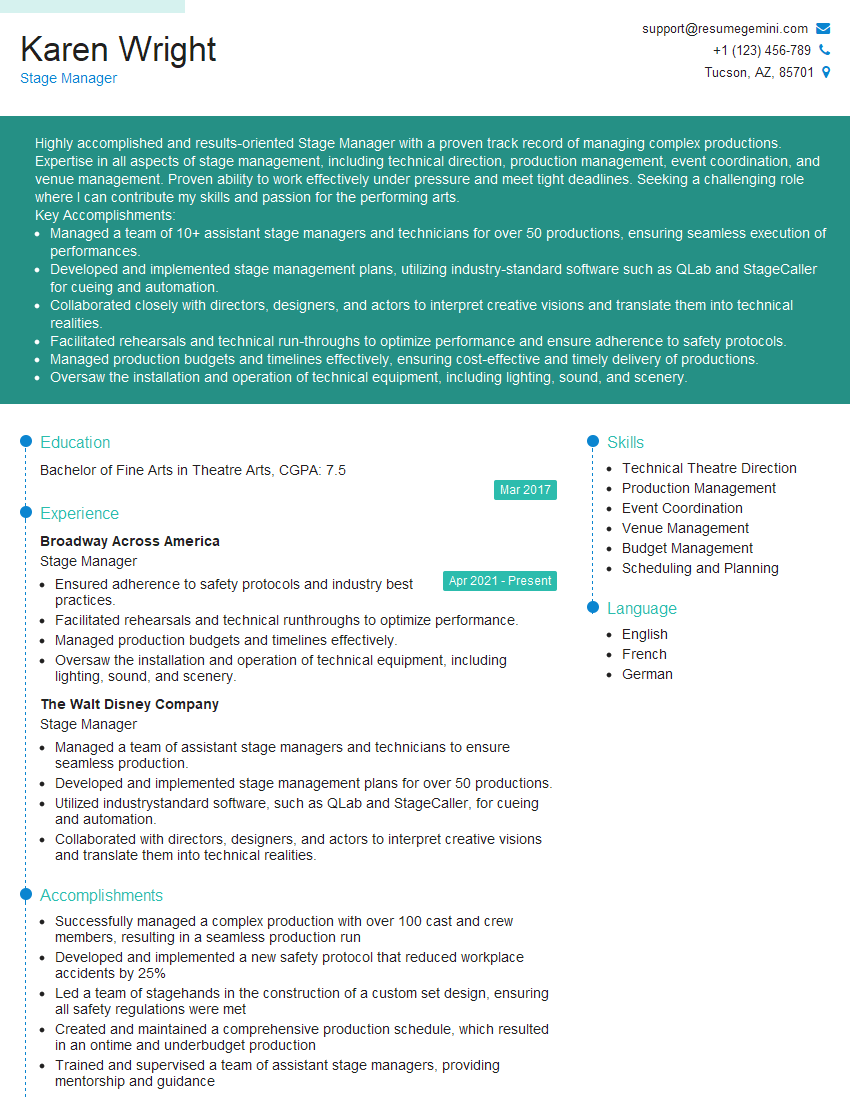The right preparation can turn an interview into an opportunity to showcase your expertise. This guide to Stage Management and Crowd Control interview questions is your ultimate resource, providing key insights and tips to help you ace your responses and stand out as a top candidate.
Questions Asked in Stage Management and Crowd Control Interview
Q 1. Describe your experience with creating and implementing a stage management plan.
Creating a stage management plan is like designing a detailed blueprint for a performance. It’s a comprehensive document outlining every aspect, from set construction and prop placement to cue timings and communication protocols. My process begins with a thorough read-through of the script and a meeting with the director to understand their vision. Then, I:
- Develop a detailed schedule: This includes rehearsal schedules, load-in/load-out plans, and a precise breakdown of each scene’s technical requirements.
- Create cue sheets: These are meticulously documented lists of all cues, including lighting, sound, set changes, and actor movements. I often use software like QLab to manage these, ensuring precise timing and smooth transitions.
- Design communication plans: This involves outlining communication channels for the entire team – from technicians to actors, ensuring everyone is informed and prepared. Clear communication is key to avoid confusion and delays.
- Conduct thorough rehearsals: This is where the plan is put into action and refined. Rehearsals are a crucial opportunity to identify potential issues and make adjustments before opening night.
- Create a comprehensive run sheet for the performance itself: This acts as a ‘live’ guide for the team, outlining the sequence of events and crucial contact information.
For example, in a recent production of ‘Hamlet’, my plan included detailed diagrams of the set, showing the exact placement of props and the route for quick changes of scenery. This ensured smooth transitions between scenes and avoided any accidental bumps during the performances.
Q 2. How do you handle unexpected technical issues during a performance?
Handling unexpected technical issues requires a calm and decisive approach. Think of it as being a firefighter – you need to act quickly and efficiently to minimize disruption. My approach involves:
- Swift assessment: Immediately identify the problem and its potential impact on the performance.
- Prioritization: Determine whether the issue is critical or can be addressed later without jeopardizing the show.
- Communication: Alert relevant personnel, including the director and the affected technical department (lighting, sound, etc.). Clear and concise communication is crucial.
- Problem-solving: Collaborate with the technicians to find a quick solution. This may involve improvising, utilizing backups, or adjusting the performance slightly.
- Documentation: After the performance, document the issue and the solution implemented. This helps in identifying areas for improvement in future productions.
For instance, during a recent musical, the main spotlight malfunctioned. We quickly switched to a backup light, and, in collaboration with the director, we adjusted a small scene to minimize the visibility of the replacement light’s slightly different color temperature. The audience was completely unaware of the technical hiccup.
Q 3. Explain your process for coordinating with various technical departments.
Coordinating with various technical departments requires excellent communication and organizational skills. It’s like conducting an orchestra – each section plays a vital role, and the conductor ensures they play in harmony. My process involves:
- Regular meetings: Scheduling regular meetings with the heads of each department (lighting, sound, costumes, etc.) to discuss progress, potential issues, and upcoming cues.
- Clear communication: Utilizing various communication methods like emails, shared online documents, and walkie-talkies for quick updates during rehearsals and performances.
- Comprehensive documentation: Keeping detailed records of all communication, technical specifications, and changes. This ensures everyone is on the same page.
- Building strong relationships: Developing a positive working relationship with each department fosters mutual respect and effective teamwork.
- Conflict resolution: Addressing conflicts promptly and professionally, finding solutions that benefit the overall production.
For example, a conflict could arise between lighting and sound if their cues overlap. I resolve this by meticulously reviewing the cues, proposing alternative timings, and creating a synchronized schedule that avoids any interference between the two departments.
Q 4. How do you manage a large team of stagehands efficiently?
Managing a large team of stagehands efficiently requires strong leadership, clear communication, and well-defined roles. I liken it to managing a sports team – each member has a specific function, and the coach guides them towards a common goal. My approach is based on:
- Delegation: Assigning specific tasks to each stagehand based on their skills and experience.
- Clear instructions: Providing concise and unambiguous instructions, ensuring everyone understands their responsibilities.
- Regular briefings: Conducting regular briefings before rehearsals and performances to reiterate instructions and address any questions.
- Positive reinforcement: Recognizing and appreciating the efforts of each stagehand, fostering a positive and motivated work environment.
- Problem-solving: Addressing any conflicts or issues promptly and fairly.
In a large-scale production, I’ll create a detailed ‘stagehand plan’ mapping responsibilities for each scene shift. This helps to avoid confusion, allowing smooth and timely set changes.
Q 5. What strategies do you use to maintain order and safety in a large crowd?
Maintaining order and safety in a large crowd is crucial for a successful event. This involves a proactive approach, anticipating potential problems and having contingency plans in place. My strategies include:
- Clear signage and pathways: Providing clear directional signage to guide the audience to their seats and exits. Well-lit pathways help to prevent accidents.
- Ushes and security personnel: Strategic placement of ushers and security personnel to assist the audience, manage crowd flow, and address any issues.
- Emergency exits and procedures: Ensuring all emergency exits are clearly marked and easily accessible. Clear emergency procedures are communicated to the staff and audience.
- Crowd control measures: Implementing crowd control measures like barriers and designated waiting areas to avoid overcrowding and maintain order.
- Communication: Using public address systems and announcements to inform the audience and direct traffic.
For large outdoor concerts, I’d work closely with local authorities to plan crowd management and have detailed escape routes in place for any emergencies. Communication is key; clear announcements, both before and during the event, are vital.
Q 6. How do you communicate effectively with performers, technicians, and audience members?
Effective communication is the cornerstone of successful stage management. It involves tailoring your communication style to each audience. With performers, I focus on building trust and rapport. With technicians, clarity and precision are paramount. With the audience, it’s about creating a positive and welcoming atmosphere.
- Performers: I use clear and concise language, avoiding jargon. Building rapport through collaborative rehearsals and providing constructive feedback helps to build a positive work environment.
- Technicians: I communicate in precise technical terms using standardized language and diagrams to avoid misunderstandings. I’m responsive to their needs and concerns.
- Audience: Warm, friendly, and clear announcements are essential. I provide helpful information, handle queries politely and efficiently, and quickly address any concerns.
- Tools: I utilize multiple communication channels – from face-to-face conversations and walkie-talkies to emails and instant messaging for different situations.
In a recent play, I used a combination of individual briefings and a shared online document to ensure seamless communication between the actors, technical crew, and myself, which resulted in a smooth and successful run.
Q 7. Describe your experience with risk assessment and safety procedures.
Risk assessment and safety procedures are paramount in stage management. It’s about identifying potential hazards and implementing measures to minimize or eliminate them. I approach this systematically, starting with:
- Hazard identification: Thorough examination of the venue, set design, equipment, and the performance itself to identify potential hazards. This includes fire risks, trip hazards, electrical dangers, and potential injuries.
- Risk assessment: Evaluating each identified hazard to determine the likelihood and severity of potential incidents.
- Mitigation strategies: Developing and implementing control measures to minimize risks. This may include providing safety training, using appropriate safety equipment, adjusting the set design, and establishing clear emergency procedures.
- Emergency procedures: Creating and regularly practicing emergency procedures including fire evacuation plans, first aid protocols, and procedures for dealing with accidents.
- Documentation: Thorough documentation of the risk assessment, mitigation strategies, and emergency procedures is essential for legal compliance and future reference.
For example, before a show involving pyrotechnics, I would conduct a thorough risk assessment, ensuring proper licenses, safety equipment, and trained professionals are in place. This process, combined with the safety briefings and well-defined protocols, helps in maintaining a safe environment.
Q 8. How do you handle conflicts or disagreements within the production team?
Conflict resolution is a crucial skill in stage management. My approach is proactive and collaborative. I believe in fostering a positive and respectful team environment where open communication is encouraged. When disagreements arise, I facilitate a structured discussion, ensuring everyone feels heard and valued. I aim to identify the root cause of the conflict, not just the symptoms. This often involves active listening, asking clarifying questions, and reframing perspectives to find common ground. For example, during a recent production of Hamlet, a disagreement arose between the lighting designer and the sound designer regarding the timing of a specific cue. Instead of taking sides, I facilitated a meeting where both designers explained their technical needs and artistic vision. We collaborated on a compromise that satisfied both parties while maintaining the integrity of the production. Ultimately, my goal is to transform conflict into a collaborative problem-solving opportunity.
Q 9. Explain your experience with scheduling and budgeting for stage productions.
Scheduling and budgeting are intrinsically linked and form the backbone of successful stage productions. My experience encompasses creating detailed production schedules using software like Google Sheets or Microsoft Project, breaking down tasks into manageable units with assigned responsibilities and deadlines. I meticulously track progress, adjusting schedules as needed based on unforeseen circumstances. Budgeting involves close collaboration with the production manager, meticulously tracking expenses against projected costs. I’m adept at identifying potential cost overruns and implementing strategies for mitigation. For example, during a recent musical, I identified a potential cost overrun in the costume department by proactively suggesting the use of repurposed fabrics and cost-effective sourcing. This saved the production thousands of dollars while maintaining high design quality. This holistic approach, combining meticulous planning and proactive cost management, ensures the production stays on time and within budget.
Q 10. Describe your experience with emergency procedures and evacuation plans.
Emergency procedures and evacuation plans are paramount in ensuring audience and crew safety. My experience includes developing and implementing comprehensive plans, compliant with all relevant safety regulations. This includes clearly marked emergency exits, designated assembly points, and trained personnel who can effectively manage evacuation procedures. I conduct regular drills to ensure everyone is familiar with the protocol. I also collaborate with local emergency services, ensuring clear communication channels are established in case of an emergency. For instance, during a large-scale outdoor event, I collaborated with the local fire department to establish clear communication protocols, including designated contact persons and emergency response pathways. Regular review and updates of these plans are crucial, reflecting changes in venue layout or potential hazards.
Q 11. How do you prioritize tasks and manage your time effectively during a live event?
Effective time management during a live event is about prioritization and adaptability. I use a variety of techniques, including creating detailed run-of-show schedules, using color-coded spreadsheets, and delegating tasks effectively. My approach is proactive; I anticipate potential delays and develop contingency plans. For example, during a live performance, if an actor misses a cue, I must rapidly assess the situation, adjusting the timing of subsequent cues to minimize disruption. This requires quick thinking and effective communication with the entire team. Utilizing a combination of pre-planning and on-the-spot problem solving helps to keep the production running smoothly.
Q 12. How familiar are you with various types of crowd control equipment?
My familiarity with crowd control equipment is extensive. This ranges from basic signage and barriers (including stanchions and ropes) to more sophisticated equipment like crowd management software and radio communication systems. I understand the importance of choosing appropriate equipment based on venue size, crowd density, and the specific event. I’m also aware of the importance of proper training for personnel using this equipment to ensure its safe and effective deployment. For example, I’ve used retractable barriers to manage queues effectively at entrances, and radio communication systems to coordinate efforts among ushers during large-scale events.
Q 13. Describe your experience with crowd flow management in high-density situations.
Managing crowd flow in high-density situations requires a strategic approach. This involves careful planning of entry and exit points, clear signage, and effective deployment of crowd control personnel. Understanding crowd psychology is crucial; I use techniques such as controlled entry and exit, channeling, and strategically placed barriers to guide the movement of crowds smoothly and safely. During a large concert, for instance, I planned multiple entry and exit points, used clear signage and color-coded pathways, and deployed ushers strategically to prevent bottlenecks and ensure safe, efficient movement of large crowds. This proactive management of crowd flow minimizes the risk of overcrowding and potential safety hazards.
Q 14. How do you identify and mitigate potential safety hazards for performers and audience?
Identifying and mitigating safety hazards is my top priority. This involves a thorough risk assessment, identifying potential hazards for both performers and audience members. This includes checking for trip hazards, ensuring proper lighting, managing potential fire risks, and addressing any structural issues. Regular safety checks, detailed pre-show inspections, and clear communication with all team members are crucial. For example, prior to a show, I performed a thorough check of the stage, noting and addressing potential tripping hazards with the stage crew. This proactive approach reduces risks, maintains a secure environment and provides peace of mind for everyone involved.
Q 15. What is your experience with using communication systems (e.g., headsets, radios)?
Effective communication is the backbone of any successful stage production. My experience with communication systems spans various technologies, from simple walkie-talkies to sophisticated multi-channel headset systems. I’m proficient in using different radio frequencies and understand the importance of clear, concise communication, especially under pressure. For example, during a recent outdoor concert, we used a three-channel system: one for the stage manager and crew, one for the lighting and sound teams, and one for security. This allowed for efficient communication and prevented any cross-talk or confusion. I’m also adept at troubleshooting technical issues with these systems, ensuring smooth communication flow throughout the event.
In another instance, while managing a theatre production, we relied heavily on headsets connected to a central intercom system. This allowed for real-time communication between the stage manager, actors, and technical crew. This ensured seamless cue execution and addressed any unexpected issues quickly and discreetly.
Career Expert Tips:
- Ace those interviews! Prepare effectively by reviewing the Top 50 Most Common Interview Questions on ResumeGemini.
- Navigate your job search with confidence! Explore a wide range of Career Tips on ResumeGemini. Learn about common challenges and recommendations to overcome them.
- Craft the perfect resume! Master the Art of Resume Writing with ResumeGemini’s guide. Showcase your unique qualifications and achievements effectively.
- Don’t miss out on holiday savings! Build your dream resume with ResumeGemini’s ATS optimized templates.
Q 16. Describe your experience with backstage organization and logistics.
Backstage organization is crucial for a smooth production. My approach emphasizes clear labeling, designated areas for props, costumes, and set pieces, and a meticulous system for tracking equipment. I utilize detailed inventory lists and diagrams to ensure nothing goes missing or gets damaged. I also work closely with the production team to create a backstage workflow that minimizes congestion and maximizes efficiency. Think of it like running a highly efficient mini-warehouse, with everything having a specific place and movement being carefully orchestrated.
For instance, during a large-scale musical production, I implemented a color-coded system for props, making it easy for crew members to quickly locate and transport items. This system significantly reduced backstage delays and improved overall efficiency. Logistics involves coordinating deliveries, managing schedules for set changes, and maintaining a safe and organized environment backstage.
Q 17. How do you ensure the timely execution of a complex stage production?
Timely execution in complex stage productions demands meticulous planning and proactive problem-solving. My approach involves creating detailed schedules, assigning specific roles and responsibilities, and using a collaborative approach involving all departments. I regularly check-in with various teams, ensuring everything is on track and addressing potential issues before they escalate. This often requires utilizing visual aids like timelines and cue sheets that everyone understands and can easily access.
A key strategy is building in buffer time. Unexpected delays are common in live events. Building flexibility into the schedule, however, helps prevent cascading problems. For instance, during a play with quick costume changes, we proactively scheduled extra time between scenes to handle any delays without jeopardizing the pacing of the entire performance.
Q 18. How do you handle audience disruptions or emergencies?
Audience disruptions and emergencies require a calm, swift, and decisive response. My training in crowd control emphasizes prioritizing safety and maintaining order. I work closely with security personnel to establish clear protocols for handling various situations. This includes knowing how to deal with medical emergencies, fire evacuations, and security threats. A crucial component is clear communication with the audience, providing instructions calmly and confidently, while minimizing panic.
During a show with a sudden power outage, my quick response involved immediately informing the audience, activating emergency lighting, and working with security to guide the audience to safe exits. Clear communication was crucial in preventing any stampedes or accidents. Post-incident, we debriefed with the security team to review what went well, what could be improved, and update our emergency protocols accordingly.
Q 19. What is your experience with creating and maintaining cue sheets?
Cue sheets are my bread and butter. They’re the essential roadmap for a production’s smooth execution. I create comprehensive cue sheets that include all relevant information: timing, cues for lighting, sound, props, actors, etc. I ensure that the format is clear, consistent, and easily accessible to everyone involved. For more complex shows, I might use digital cue sheets or specialized software to manage cues more efficiently, ensuring accurate and synchronized execution.
For example, when working on a dance performance, I used a software program with time-coded cues that enabled precise syncing of the lighting and music. This digital format also allowed us to make minor adjustments on the fly, minimizing downtime.
Q 20. Describe your experience with working with union personnel.
Working with union personnel requires a deep understanding of collective bargaining agreements and established protocols. Building rapport with union representatives is critical. Clear communication and respect for their expertise are essential. I’ve consistently worked with union members by ensuring they have everything they need to do their jobs effectively, while maintaining adherence to union contracts and regulations.
During a recent production, I meticulously followed union guidelines regarding call times, breaks, and work conditions. Open communication and building trust with the union representatives ensured a smooth working relationship, avoiding any potential conflicts.
Q 21. Explain your experience with post-event reporting and analysis.
Post-event reporting and analysis are vital for continuous improvement. After every production, I create a comprehensive report that details the successes, challenges, and areas for improvement. This includes analyzing the efficiency of workflows, identifying any technical glitches, and assessing audience feedback. These reports allow for continuous improvement and inform future productions. For example, after one event, a report highlighted the inefficiency of a particular prop change. Based on this analysis, we revamped that section of the schedule, improving efficiency for future shows.
I also believe in using data to inform decision-making. Audience feedback surveys, box office data, and technical logs can all contribute to a more holistic understanding of an event’s success and provide valuable insights into future planning. This data-driven approach allows for more informed choices and ensures ongoing optimization of future productions.
Q 22. How do you adapt your stage management strategies to different types of events?
Adapting stage management strategies depends heavily on understanding the unique demands of each event. A small theatrical production will have vastly different needs than a large-scale concert or a corporate event. My approach involves a detailed pre-production planning phase where I meticulously analyze the event type.
- Type of Event: A play requires meticulous scene changes and prop management, whereas a concert focuses on lighting, sound cues, and artist transitions. A corporate event might prioritize seamless AV presentations and efficient audience flow.
- Venue Size and Layout: The size and configuration of the venue directly influence logistics. A large arena necessitates different crowd control measures compared to an intimate theatre. I would consider things like entrances, exits, seating arrangements, and backstage access.
- Audience Expectations: Understanding the audience’s demographics and expectations helps tailor the experience. A family-friendly show will have different safety protocols and atmosphere compared to a high-energy rock concert.
- Technical Requirements: This includes considering the complexity of the lighting, sound, video, and special effects. A simpler setup allows for leaner stage management, while complex productions require a larger team and advanced planning.
For instance, while managing a children’s theatre production, I focused on quick, engaging scene changes and incorporated interactive elements to maintain the children’s attention. In contrast, for a corporate presentation, I prioritized a seamless flow of presentations, ensuring the right AV equipment was available at the right time, and managing audience Q&A smoothly.
Q 23. How do you use technology to enhance stage management and crowd control efficiency?
Technology is indispensable for enhancing efficiency in both stage management and crowd control. I leverage several tools to streamline operations and improve the audience experience.
- Stage Management Software: Software like QLab or Stage Manager allows for precise scheduling of cues, communication with the technical crew, and real-time adjustments. This minimizes errors and ensures smooth transitions.
- Communication Apps: Apps like Slack or WhatsApp facilitate instant communication among the stage crew, ensuring everyone is informed and coordinated. This is especially crucial during complex productions.
- Crowd Management Apps: Apps offering real-time crowd analytics, mapping, and entry/exit monitoring can help optimize crowd flow, identify potential bottlenecks, and ensure safety. This data can inform decisions on staffing levels and emergency procedures.
- Digital Ticketing and Registration: These systems allow for seamless entry, improve data collection, and assist in managing capacity limits. They minimize queues and enhance the overall experience.
For example, during a large outdoor festival, I used a crowd management app to monitor real-time crowd density, allowing us to proactively adjust security personnel deployment and prevent overcrowding. This prevented potential safety hazards and enhanced the overall audience safety and enjoyment.
Q 24. Describe your experience with using various stage management software.
My experience spans several stage management software packages, each with its strengths and weaknesses. I’m proficient in QLab, a highly versatile and powerful software perfect for complex productions needing precise timing and coordination of cues. Its ability to integrate with other software and hardware makes it ideal for large-scale productions. I’ve also used simpler software like Stage Manager, which is a better fit for smaller-scale events that don’t need the advanced features of QLab. I am also familiar with other systems like ETC EOS and Vectorworks, demonstrating adaptability to different technological environments.
My experience includes using these tools for diverse applications, from managing lighting and sound cues in theatre productions to coordinating AV elements in corporate conferences. I find that understanding the specific capabilities of different software packages is key to effectively utilizing them for the project’s unique needs. For example, for a recent concert, QLab allowed for pre-programming and precise timing of lighting cues that synced perfectly with the music, resulting in a truly dynamic visual show.
Q 25. How do you ensure accessibility for audience members with disabilities?
Ensuring accessibility for audience members with disabilities is paramount and requires proactive planning. This encompasses several aspects:
- Wheelchair Accessibility: Sufficient, clearly marked wheelchair spaces, ramps, and accessible restrooms must be provided. I coordinate with venue staff to ensure these are readily available and clearly communicated.
- Assistive Listening Devices: Providing assistive listening devices for hearing-impaired individuals is crucial, ensuring they can fully enjoy the event. I work with the venue to ensure adequate availability and functionality.
- Visual Aids: For visually impaired attendees, providing large print programs, audio descriptions, or tactile guides can greatly enhance their experience.
- Clear Signage and Communication: Utilizing clear, accessible signage and announcements, including braille and audio descriptions where necessary, is vital for effective navigation and information access.
- Trained Staff: Ensuring trained staff are available to assist individuals with disabilities is crucial. This involves providing staff training on accessibility procedures and protocols.
For a recent performance, I worked closely with a disability advocacy group to ensure the venue met accessibility standards and created a detailed accessibility guide for the audience. This resulted in many people with disabilities being able to enjoy the event with ease.
Q 26. What is your experience with working under pressure and meeting tight deadlines?
Working under pressure and meeting tight deadlines is inherent in stage management. I thrive in fast-paced environments. My experience has honed my skills in prioritization, delegation, and problem-solving under pressure. I utilize detailed schedules, regular check-ins with the team, and proactive risk assessment to manage potential issues.
For example, during a live broadcast, a crucial piece of equipment malfunctioned just minutes before airtime. I swiftly coordinated with the technical team, found a suitable replacement, and implemented a quick fix, ensuring the broadcast proceeded without interruption. This required rapid decision-making, resourcefulness, and clear communication.
Q 27. Describe a time you had to make a quick, critical decision during a performance.
During a theatrical production, a lead actor experienced a sudden medical emergency mid-performance. I had to make an immediate decision. First, I ensured the actor received medical attention by dispatching the designated emergency personnel, then I calmly signaled the understudy to quickly prepare, all while maintaining composure and continuing to manage the ongoing performance, keeping the audience unaware of the situation as much as possible. This involved quickly adapting the scene flow and cues to seamlessly integrate the understudy. The show continued without major disruption, demonstrating swift response, teamwork, and crisis management skills.
Q 28. How do you balance artistic vision with practical constraints in stage management?
Balancing artistic vision with practical constraints is a core aspect of stage management. It requires understanding both the director’s creative vision and the limitations of the budget, venue, and available resources. This involves open communication, proactive problem-solving, and creative compromises.
Imagine a director wanting a complex, elaborate set design for a play with a limited budget. Rather than simply rejecting the vision, I would work closely with the design team to explore cost-effective alternatives. This could involve finding simpler materials, repurposing existing sets, or using creative projection mapping to suggest the desired effects without the need for a lavish physical set. The key is collaborative brainstorming to achieve a compromise that respects the artistic vision while remaining practically feasible.
Key Topics to Learn for Stage Management and Crowd Control Interview
- Production Scheduling & Organization: Understanding call sheets, running orders, and the ability to efficiently manage time and resources during rehearsals and performances.
- Communication & Collaboration: Effective communication with directors, actors, technical crews, and venue staff; fostering a collaborative environment.
- Risk Assessment & Safety Protocols: Identifying and mitigating potential hazards, implementing safety procedures for both performers and audience members, and emergency response planning.
- Technical Aspects of Stage Management: Familiarity with stage equipment, lighting, sound, and set changes; understanding cueing systems and their execution.
- Crowd Control Techniques: Managing audience flow, addressing audience inquiries and concerns, handling emergencies or disruptive behavior, and implementing appropriate crowd management strategies for different venue types and event sizes.
- Problem-Solving & Adaptability: Demonstrating the ability to think on your feet, troubleshoot technical issues, and adapt to unexpected challenges during live events.
- Budget Management & Resource Allocation: Understanding and managing budgets related to stage management and crowd control; efficiently allocating resources to maximize effectiveness.
- Legal & Regulatory Compliance: Awareness of relevant health and safety regulations, licensing requirements, and legal considerations related to event management.
Next Steps
Mastering Stage Management and Crowd Control opens doors to exciting career opportunities in theatre, events, film, and beyond. These skills are highly sought after, demonstrating your organizational prowess, leadership abilities, and dedication to safety. To maximize your job prospects, crafting a compelling and ATS-friendly resume is crucial. ResumeGemini is a trusted resource that can help you build a professional resume that highlights your unique skills and experience. We provide examples of resumes tailored to Stage Management and Crowd Control to help you get started. Take the next step toward your dream career – build a winning resume with ResumeGemini today!
Explore more articles
Users Rating of Our Blogs
Share Your Experience
We value your feedback! Please rate our content and share your thoughts (optional).
What Readers Say About Our Blog
Hello,
We found issues with your domain’s email setup that may be sending your messages to spam or blocking them completely. InboxShield Mini shows you how to fix it in minutes — no tech skills required.
Scan your domain now for details: https://inboxshield-mini.com/
— Adam @ InboxShield Mini
Reply STOP to unsubscribe
Hi, are you owner of interviewgemini.com? What if I told you I could help you find extra time in your schedule, reconnect with leads you didn’t even realize you missed, and bring in more “I want to work with you” conversations, without increasing your ad spend or hiring a full-time employee?
All with a flexible, budget-friendly service that could easily pay for itself. Sounds good?
Would it be nice to jump on a quick 10-minute call so I can show you exactly how we make this work?
Best,
Hapei
Marketing Director
Hey, I know you’re the owner of interviewgemini.com. I’ll be quick.
Fundraising for your business is tough and time-consuming. We make it easier by guaranteeing two private investor meetings each month, for six months. No demos, no pitch events – just direct introductions to active investors matched to your startup.
If youR17;re raising, this could help you build real momentum. Want me to send more info?
Hi, I represent an SEO company that specialises in getting you AI citations and higher rankings on Google. I’d like to offer you a 100% free SEO audit for your website. Would you be interested?
Hi, I represent an SEO company that specialises in getting you AI citations and higher rankings on Google. I’d like to offer you a 100% free SEO audit for your website. Would you be interested?
good


